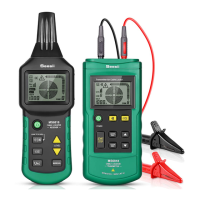Operating instructions for Cable Detector, article 37270766
Page 31 of 34
7. Technical parameters
7.1 Technical parameters of the transmitter
External voltage identification range
DC 12~400V±2.5%; AC 12~400V(50-60Hz±2.5%;
LCD with function display and column diagram
Dielectric stability, external voltage
0°C to 40°C, max. rel. humidity 80 % (no condensation)
-20°C to 60°C, max. rel. humidity 80 % (no condensation)
7.2 Technical parameters of the receiver
Tracking depth depends on the material and specific application
Grid voltage identification
LCD with function display and column diagram
0°C to 40°C, max. rel. humidity 80 % (no condensation)
-20°C to 60°C, max. rel. humidity 80 % (no condensation)
8. Repair and maintenance
1. If the detector does not appear to be working, first make sure that the batteries have enough power and
the test lead is not defective.
2. Before sending the detector in for repair, take out the battery, describe the problem, and pack the device
properly in order to prevent damage during shipping. We accept no liability for shipping damage.
3. There is a fuse in the transmitter. If this is damaged during the warranty period, it can be replaced only be
technical customer service. If it is damaged after the warranty period, replace it with a new fuse of the
same type. The fuse is a fast-melting single metal wire fuse; do not replace it with a slow spiral wire fuse,
since otherwise transmission performance and device safety cannot be ensured.
8.1 Troubleshooting
If the detector is not working property, check the points in the table below:
Device will not
switch on
Is the battery power too low?
Is the battery polarity correct?
Transmitter cannot
identify external

